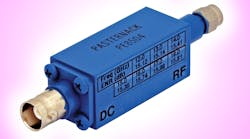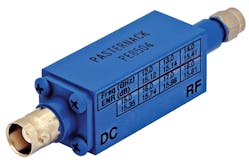This file type includes high resolution graphics and schematics when applicable.
Noise sources have long served as practical test tools for evaluating different aspects of communications systems. In fact, additive white Gaussian noise (AWGN) sources helped establish many early wireless communications channels, allowing system architects to evaluate mechanical, electrical, and environmental effects on noise signal levels sent through a channel to be tested.
However, the growing complexity of wireless systems, from simple analog channels to more elaborate digitally modulated channels, demanded more complex test sources. Most notably, they had to emulate such effects as signal fading, multipath distortion, interference, and other propagation impediments.
Still, the venerable noise source remains an inexpensive component for a wide range of test applications: modeling the noise in a communications channel; testing the signal quality of a satellite-communications (satcom) link; performing bit-error-rate (BER) testing on a digital communications channel; calibrating RF and microwave vector network analyzers (VNAs); performing noise-figure measurements; and used as a built-in test component for a wide array of instruments. To serve these and many other applications, Pasternack Enterprises recently introduced a series of coaxial AWGN noise sources covering frequencies from 2 to 18 GHz with a number of different noise output levels.
A noise source can be as simple as a packaged or unpackaged diode or an amplified diode in a compact housing with coaxial connectors, or as complex as a microprocessor-controlled, noise-generating instrument with a variety of additional capabilities. Pasternack’s initial noise components represent the former type, in small aluminum enclosures with BNC or SMA connectors, built to survive the handling on a test bench and in multiple types of measurement systems.
The product line includes 10 models (parameters are detailed in the table). Noise sources come in frequency ranges of 1 to 2 GHz, 2 to 4 GHz, 4 to 8 GHz, 8 to 12 GHz, and 12 to 18 GHz. Medium- and high-power versions are available, offering excess-noise-ratio (ENR) output levels of 15, 30, or 32.5 dB, depending on the model. These high output noise levels make the sources useful for the most common test applications, including measurements of BER and noise figure. Here, noise sources with lower ENR are less desirable.
The ENR values also correlate well with the standard calibration points of noise-figure meters and RF/microwave spectrum analyzers. The 15-dB ENR models are perhaps the most versatile, as they can be used for measurement of both low and high noise figures, while the 30- and 32.5-dB models are best suited for high-noise-figure test scenarios. The noise sources exhibit VSWRs of either 1.20:1 or 1.35:1, and feature rise/fall times of 1 µs or better.
All models are rated for operating temperatures of –55 to +85°C and require 25-mA current at a bias voltage of +28 V dc. With regard to the BNC and SMA connector interfaces, male connectors are located on the input port and female connectors sit on the output port. All models are in stock for same-day shipping.
This file type includes high resolution graphics and schematics when applicable.
Tim Galla is a Product Engineer at Pasternack Enterprises.
Pasternack Enterprises, 17802 Fitch, Irvine, CA 92614; 866-727-8376, E-mail: [email protected].



